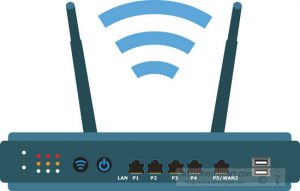
How to Check If Your Home Router Is Vulnerable or Not
– By Megha Malhotra
Cybersecurity these days requires more (and better) defensive measures than any time in recent memory. These measures run from receiving what are recognized as best practices, through helping end-clients to remain all around educated about forthcoming dangers and how to dodge them, to executing web security innovation and staying up with the latest.

In a powerful domain where dangers constantly advance and new weaknesses are recognized practically day by day, it is important to go through the most to-date security devices, since they manage insurance measures for new and ever-moving assault vectors.
Most door switches utilized by home clients are significantly not secure. A few switches are so powerless against assault that they ought to be tossed out, a security master said at the HOPE X programmer gathering in New York.
• Best Wi-Fi switches for your home or little office
• The best antivirus programming to keep your PC clean
• Modem versus switch: How they’re extraordinary and what they do
Horowitz suggested that security-cognizant customers rather move up to business switches proposed for private ventures, or if nothing else separate their modems and switches into two separate gadgets. (Many “passage” units, frequently provided by ISPs, go about as both.) Failing both of those choices, Horowitz gave a rundown of safeguards clients could take.
Regardless of whether we are talking about the work, school or home condition, security must consider and ensure all components that could get entryways for potential assaults. In this article we will audit some security angles clients should take a gander at in a home system ―particularly those identified with the arrangement of its internet connected routers.
Issues with customer routers

Switches are the fundamental yet unheralded workhorses of present day PC organizing, yet hardly any home clients acknowledge they are in truth undeniable PCs, with their own working frameworks, programming and weaknesses.
Numerous shopper grade home-passage gadgets neglect to tell clients if and when firmware refreshes become accessible, despite the fact that those updates are fundamental to fix security gaps, Horowitz noted. Some different gadgets won’t acknowledge passwords longer than 16 characters.
A great many switches all through the world have the Universal Plug and Play (UPnP) organizing convention empowered on web confronting ports, which opens them to outside assault.
Another issue is the Home Network Administration Protocol (HNAP), an administration apparatus found on some more seasoned purchaser grade switches that sends delicate data about the switch over the Web at http://[router IP address]/HNAP1/, and gives full control to far off clients who give authoritative usernames and passwords (which numerous clients never show signs of change from the plant defaults).
In 2014, a switch worm called The Moon utilized the HNAP convention to recognize helpless Linksys-brand switches to which it could spread itself. (Linksys immediately gave a firmware fix.)
The WPS threat
Most noticeably terrible of everything is Wi-Fi Protected Setup (WPS), a convenience include that lets clients sidestep the system secret word and interface gadgets to a Wi-Fi organize essentially by entering an eight-digit PIN that is imprinted on the switch itself. Regardless of whether the system secret phrase or system name is changed, the PIN stays substantial.
That eight-digit PIN isn’t even extremely eight digits, Horowitz clarified. It’s really seven digits, in addition to a last checksum digit. The initial four digits are approved as one grouping and the last three as another, subsequent in just 11,000 potential codes rather than 10 million.
At that point, there’s organizing port 32764, which French security specialist Eloi Vanderbeken in 2013 found had been discreetly left open on door switches sold by a few significant brands. Utilizing port 32764, anybody on a nearby system — which incorporates a client’s ISP — could take full managerial control of a switch, and even play out an industrial facility reset, without a secret key.
The port was shut on most influenced gadgets following Vanderbeken’s divulgences, yet he later found that it could without much of a stretch be resumed with a uniquely planned information parcel that could be sent from an ISP.
Step by step instructions to secure your home switch

The initial move toward home switch security, Horowitz stated, is to ensure the switch and link modem are not a solitary gadget. Numerous ISPs rent such gadgets to clients, yet they’ll have little power over their own systems. (On the off chance that you have to get your own modem, look at our proposals for the best link modem.)
Next, Horowitz suggested that clients purchase a low-end business grade Wi-Fi/Ethernet switch, for example, the Pepwave Surf SOHO, which retails for about $200 (however be careful value gougers), as opposed to a buyer well disposed switch that can cost as meagre as $20.
Business grade switches are probably not going to have UPnP or WPS empowered. The Pepwave, Horowitz noted, offers extra highlights, for example, firmware rollbacks on the off chance that a firmware update turns out badly.
Whether or not a switch is business or buyer grade, there are a few things, changing from simple to troublesome, that home-organize managers can do to ensure their switches are safer:
1. Conduct router connectivity and authentication tests
Routers permit organization and setup utilizing a few ports in the neighbourhood arrange; this should be possible through Ethernet link or remote association. Generally you can arrange your switch by means of the web, yet switches additionally permit associations for different administrations and ports, for example, FTP (port 21), SSH (22), Telnet (23), HTTP (80), HTTPS (443), or SMB (139, 445).
Notwithstanding these, there are different other notable and all around utilized administrations whose default ports are built up as web guidelines ―defined by the Internet Assigned Numbers Authority (IANA). In spite of the fact that the blocked port design may be set in your switch of course, you can audit it to determine the status and arrangement settings. As it were, you can empower just the administrations you need, handicap all others, and square unused ports. In any event, for far off associations, aside from where they are fundamental.
A similar rationale applies to the utilization of passwords for the executives of administrations. In the event that conceivable, you should change both (administrator) secret word and username, so nor is the out-of-the-crate default. On the off chance that the switch default secret key has not been transformed, it could be known to, or handily speculated by, assailants; if that is the situation, they can sign into your switch and reconfigure it, or bargain your system.
Likewise, we instruct the utilization with respect to long and complex passwords, or a passphrase for these reasons; you can utilize a secret key director to make and store passwords in a sheltered spot. Subsequently, it is essential to survey the arrangement of administrations and ports, the client accounts and the quality of passwords.
2. Perform vulnerability tests on the router
There is another viewpoint to consider when searching for powerless focuses in your switch settings – tests for switches that can be done utilizing devices that computerize undertakings, for example, searching for known weaknesses. This kind of hardware incorporates data, alternatives and recommendations on the best way to tackle these potential issues. Assailants utilize comparative instruments to distinguish weaknesses in your switch, so it’s a smart thought to utilize them as well, with the goal that your switch is not, at this point low-hanging organic product
Some switch tests incorporate checking for port weaknesses, pernicious DNS worker notoriety, default or simple to-break passwords, weak firmware, or malware assaults. Some likewise incorporate weakness investigation of the switch’s web worker segment, searching for issues, for example, cross-website scripting (XSS), code infusion or distant code execution.
On the off chance that you don’t think about these assaults and penetrates, make certain to discover a switch test (or a gathering of tests) that does however much as could reasonably be expected of the difficult work for you. While it is anything but a total test, a decent method to begin could be with the Connected Home Monitor device.
3. Verify connected devices in the network
A third part of keeping up the best possible working and execution of the switch and the system is the ID of associated gadgets. In some cases, because of terrible practices and the utilization of weak conventions, it’s workable for confided in gadgets to interface without appropriate approval, and furthermore for untrusted gadgets to associate.
It is along these lines a smart thought to know about and ready to distinguish all the gadgets that interface with your switch: right off the bat, to keep away from the utilization of assets by outsiders that do so misguidedly and corrupt the system’s presentation, and also, as a safety effort, to keep your data from being undermined.
Regardless of whether this check is done through a mechanized device or by physically utilizing the switch’s organization choices, the fitting subsequent stage comprises of allowing permitted gadgets just, by utilizing channels to limit access to explicit IP locations or MAC tends to as it were.
To begin this movement, the Connected Home Monitor instrument gives a simple to-get to rundown of associated gadgets, ordered by gadget type (for example printer, switch, cell phone, etc), to show what is associated with your home system. At that point, you should roll out the improvements yourself utilizing your switch interface.
4. Update all devices on the home system
The ongoing updates on the weakness known as KRACK (Key Reinstallation Attack), which permits the block attempt of traffic between gadgets that associate with a passage in a Wi-Fi organize, underscores again the significance of updates.
For an assault to exploit this weakness, its culprit would typically must be close to the proposed casualty’s Wi-Fi organize. Achievement would permit the aggressor to keep an eye on correspondences or introduce malware. We generally prescribe refreshing all gadgets associated with your system (like PCs, cell phones or tablets), when the makers distribute the security fixes that address the weakness; likewise introduce the updates to the firmware of the switches, when patches are accessible.
Different practices, for example, arranging PCs for “Open Network” mode, increment the security level of the gadget contrasted with the “Private/Home” organize mode, since it decreases the danger of assault across confided in gadgets. We might want to pressure that the most basic activity is to keep PCs and gadgets refreshed.
5. Empower security choices
A fifth attractive practice is to empower the security choices that are accessible in the setup of the switch, which differ contingent upon the model and sort of gadget. Notwithstanding the switch model utilized in your home system, we exhort that you empower security alternatives that are intended to offer more insurance of your gadgets and the system.
For instance, some ongoing switches incorporate design choices that permit expanded security against known Denial of Service (DoS) assaults, for example, SYN Flooding, ICMP Echo, ICMP Redirection, Local Area Network Denial (LAND), Smurf and WinNuke. On the off chance that empowering these choices forestalls your switch and system performing appropriately, specifically handicap them to improve execution.
Simple fixes
1. Change the regulatory accreditations from the default username and secret word. They’re the main things an aggressor will attempt. Your switch’s guidance manual should tell you the best way to do this. On the off chance that it doesn’t, at that point Google it. Make the secret key long, solid and exceptional, and don’t make it anything looking like the customary secret phrase to get to the Wi-Fi arrange.
2. Change the system name, or SSID, from “Netgear,” “Linksys” or whatever the default is, to something one of a kind — however don’t give it a name that distinguishes you.
3. Turn on programmed firmware refreshes on the off chance that they’re accessible. More up to date switches, including most work switches, will naturally refresh the switch firmware. Empower WPA2 remote encryption with the goal that solitary approved clients can bounce on your system. In the event that your switch can bolster just the old WEP standard, it’s the ideal opportunity for another switch.
4. Empower the new WPA3 encryption standard if the switch bolsters it. As of mid-2020, be that as it may, scarcely any switches and customer gadgets (PCs, cell phones, brilliant home gadgets) do.
5. Impair Wi-Fi Protected Setup, if your switch lets you. Set up a visitor Wi-Fi system and offer its utilization to guests, if your switch has such an element. On the off chance that conceivable, set the visitor system to turn itself off after a set timeframe. Horowitz said. “That is an extremely pleasant security include.” In the event that you have a ton of savvy home or Internet of Things gadgets, chances are a considerable lot of them won’t be frightfully secure. Associate them your visitor Wi-Fi arrange rather than your essential system to limit the harm coming about because of any possible trade off of an IoT gadget.
6. Try not to utilize cloud-based switch the board if your switch’s maker offers it. Rather, make sense of in the event that you can kill that highlight. “This is a downright awful thought,” for example, Google Wi-Fi and Euro, are altogether cloud-subordinate and can interface with the client just through cloud-based cell phone applications.
While those models offer security enhancements in different territories, for example, with programmed firmware refreshes, it may merit searching for a work style switch that licenses neighbourhood authoritative access, for example, the Net gear Orbit.